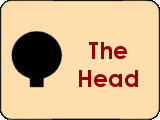The
Head

We have been studying the control of eye movements for the Babybot. Various behaviors were implemented that allow the robot to visually explore the environment in search of interesting objects and events. The simplified Babybot's visual system can detect color and motion. The robot also uses binocular disparity to gather information about the depth in the visual scene and control vergence.
The head is embedded with three gyroscopes that are used by the Babybot to develop the sense of a stable world. Visual stability of the world is of course important to perceive it correctly: the visual processing is simpler if the eyes are not moving too much. Also, these signals can be used to actively coordinate the movement of the head with that of the eyes (compensatory eye movements). Experiments investigated different types of self-supervised learning to automatically tune the performance of this class of eye movements.
We carried out experiments on learning saccade (fast eye movements) towards visually identified targets. Neural networks techniques were employed for this task.
Controlling the movement of the eyes and head is one of the first step required in learning complex cognitive tasks. It also rests at the foundation of reaching and manipulation.







